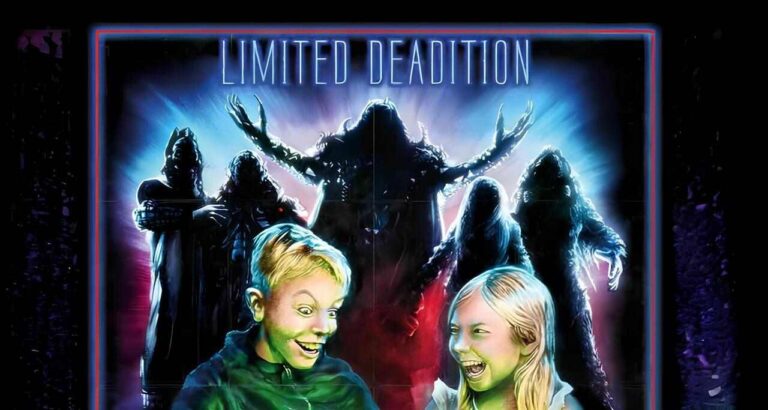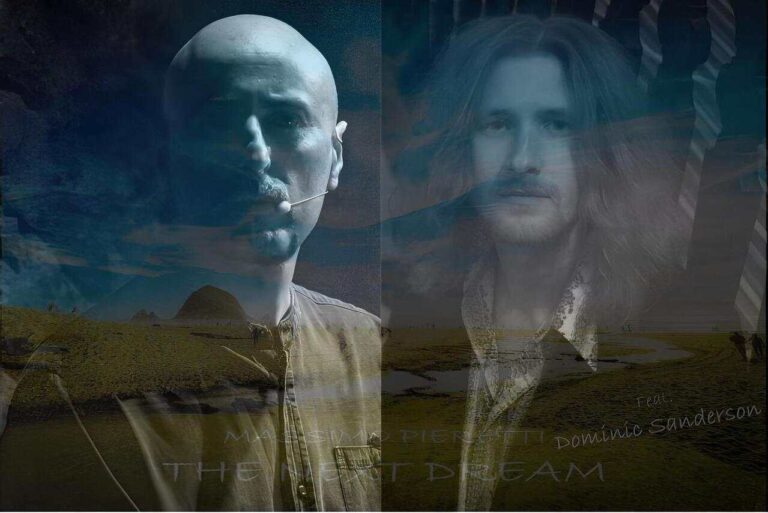“The Velvet Underground and Nico”. Le difficoltà e le tribolazioni del capolavoro dell’Art Rock
“The Velvet Underground and Nico” è stato registrato ad aprile, maggio e novembre del 1966 e pubblicato a marzo del 1967. Andy Warhol fungeva da manager della band, la finanziò e realizzò il design della cover del loro primo album. Il che significò una creazione di Warhol, una banana di plastica nella copertina, che sbucciata lascia vedere la banana all’interno. Questa banana di plastica è stata una delle ragioni del ritardo nella release dell’album, unita ai vari ritardi durante il processo di produzione.
L’album contiene musica d’avanguardia mescolata con lo stile caratteristico hard rock, insieme alle controverse lyrics di Lou Reed.
Un album capolavoro di avant garde
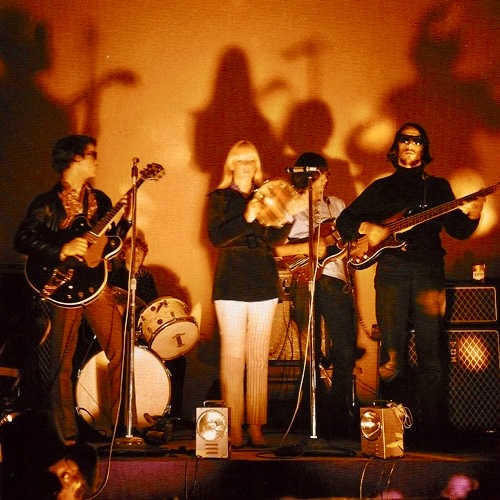
The Velvet Underground riuscirono a creare un capolavoro di art rock unico. Non c’era niente del genere in giro in quel periodo. Fu un enigma per il quale il mondo della musica commerciale non era pronto. I genitori ne erano orrificati, i teenyboppers…anche. Perlomeno quelli che si degnarono di ascoltarlo o anche soltanto di interessarsene. La cosa fu un grande peccato perché quell’album era un tour de force in quanto a espressione innovativa della musica avant-garde. Quella che strappò il libro delle regole su come una canzone rock dovrebbe essere scritta. E questo era molto al di la di quei tempi. Ci sarebbero voluti anni prima che quel disco guadagnasse il merito che meritava.
Il line-up dei Velvet Underground all’epoca
I membri dei Velvet Underground all’epoca delle registrazioni includevano Lou Reed, lead vocalist e maggiore compositore, celebre per il suo distintivo modo di cantare “parlato”. Il multistrumentalista John Cale, nativo del Galles, aggiunse un vibe unico e sperimentale al sound della band con una varietà di strumenti. Mentre il ritmo della chitarra di Sterling Morrison portò un sound “fuzz” alla mistura. La batterista Maureen Tucker contribuí con il suo drumming minimale ma di grande impatto. Questo insieme di musicisti si fece conoscere per lo stile sperimentale ed avant card, arricchite da lyrics controverse.
Nico entra in scena nei Velvet Underground
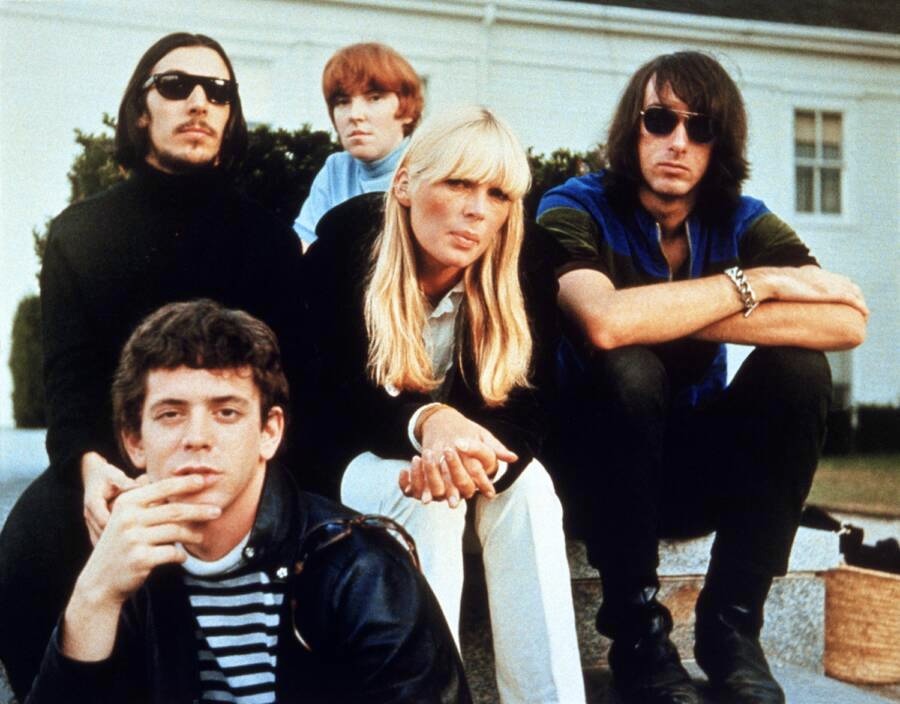
Originariamente i membri dei Velvet Underground erano quattro: Lou, John, Sterling e Maureen. Erano dark e spigolosi ma Andy Warhol sentiva che avevano bisogno di qualche altra cosa. Quel qualcosa in più era Nico. Nico era apparsa in un certo numero di film di Warhol, con la sua voce che era stata paragonata a quella di Marlene Dietrich. Tirando i fili del portafogli del gruppo, Andy persuase Lou ad includere Nico nel line up. E sebbene ci fossero seri dubbi riguardo Nico, Lou decise di tirare avanti con la cantante che si uní al gruppo. Nico avrebbe sostituito Lou alle lead vocals per tre tracks dell’album, “I’ll Be Your Mirror”, “Femme Fatale” e “Tomorrow’s Parties. Lei cantò anche come backup in “Sunday Morning”. In più, andò in tour con la band nell’ Exploding Plastic Inevitable Extravaganza di Warhol.
L’album ”The Velvet Underground and Nico”
Il disco fu registrato a metà aprile del 1966. Il fulcro venne realizzato in quattro giorni con alcuni addizionali ri-registrazioni che ebbero luogo quello stesso anno. Le registrazioni iniziali avvennero allo Spectre Records a New York City. Si stima che il costo di registrazioni sia andato dai 1.500 dollari ai 3.000 dollari. La release del disco venne un pochino ritardata. Ci fu un problema nel reperire un’etichetta che accettasse di pubblicarlo a causa delle tematiche ostiche nelle lyrics. Ma dopo essersi guardati un po’ intorno ed essere stati respinti da un certo numero di etichette discografiche, l’album finalmente fu accolto dall’etichetta MGM Records Verve.
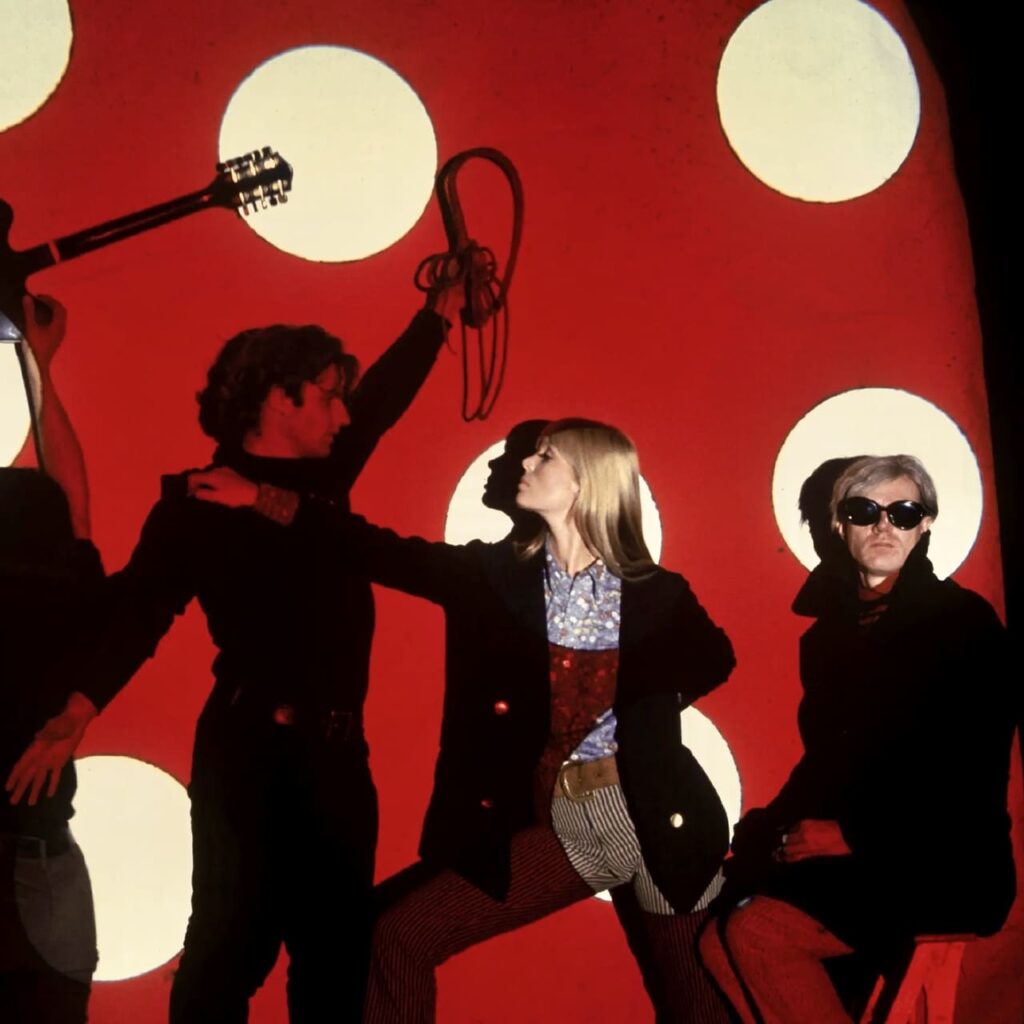
Venne prodotto da Tom Wilson. Sebbene abbastanza stranamente Andy Warhol è citato nei crediti della copertina del disco come unico produttore, più probabilmente fu denominato produttore grazie al suo nome molto celebre e funzionale nel marketing. Anche se Andy ebbe ben poco a che fare con il processo di registrazione al di fuori dell’aver pagato lui per le sessions in studio. Lou Reed e Sterling Morrison assicurarono entrambi che Warhol diede alla band la massima libertà di fare le cose come volevano loro per quello che riguardava la direzione musicale dell’album. Con la loro libertà artistica i Velvet Underground riuscirono a realizzare velocemente un album estremamente anticonvenzionale, con musiche e temi al di sopra dell’usuale. E’ un album che si fa notare per l’inclusione di tematiche che riguardavano la vita reale, argomenti di cui usualmente non si parlava in pubblico ai tempi dell’uscita del disco.
Un’accoglienza iniziale piuttosto “tiepida” per quello che sarebbe diventato un capolavoro rock
Nel 1967, sebbene le cose stessero cambiando rapidamente durante gli anni del Potere dei Fiori, le droghe pesanti come l’eroina e le pratiche sessuali proibite erano soggetti tabù. Specialmente in radio. Cosa che penalizzò il disco dal punto di vista delle vendite. Si presume che “The Velvet Underground and Nico” abbia venduto soltanto 33.000 copie nei suoi primi cinque anni di esistenza. Questo album dark, eccentrico, fu insomma abbastanza ignorato ai tempi della sua pubblicazione. Ma con il tempo sarebbe diventato uno degli album più rivoluzionari ed influenti di tutti i tempi.
Un team di artisti iconici per uno degli album più influenti dei ’70
Fu la quasi cosmica collaborazione tra Lou Reed, Andy Warhol, Nico, John Cale, Sterling Morrison e Mureen Tucker che permise all’album di essere talmente unico. Sembrava che fosse venuto fuori dal nulla. Non c’era niente che avesse neanche lontanamente suonato in quel modo in precedenza. La società non era pronta per una cosa simile. Le stazioni radio si rifiutarono di trasmetterlo, i giornali e le riviste si rifiutarono di pubblicizzarlo. Era strambo, con testi che potevano intimorire, completamente fuori portata rispetto ai gusti correnti in fatto di rock. L’album aveva contro qualsiasi cosa potesse avere contro. Ma tutto questo con il tempo sarebbe cambiato.
Verso la metà degli anni ’70 l’album “The Velvet Underground and Nico”, dal suo piccolo seguito cult, sarebbe stato riconosciuto come uno dei più influenti dischi rock mai incisi.
I brani di “The Velvet Underground and Nico”
La side one dell’album inizia con “Sunday Morning”. Come le registrazioni progredivano, il produttore Tom Wilson pensò che si potesse inserire un altro brano di Nico. Così subito dopo “Sunday Morning”, Lou Reed e John Cale si misero insieme a scrivere un pezzo ispirato alla voce di Nico. Ma Lou finí per cantare da lead vocalist, mentre Nico procurò altre parti di vocals. John Cale contribuí con la celesta, la viola e il piano per aiutare a creare l’arrangiamento sognante di “Sunday Morning”. Così Lou era alle lead vocals e alla chitarra, Nico alle backing vocals, Sterling Morrison al basso e Maureen Tucker alla batteria.
La storia di “I’m waiting for the Man”
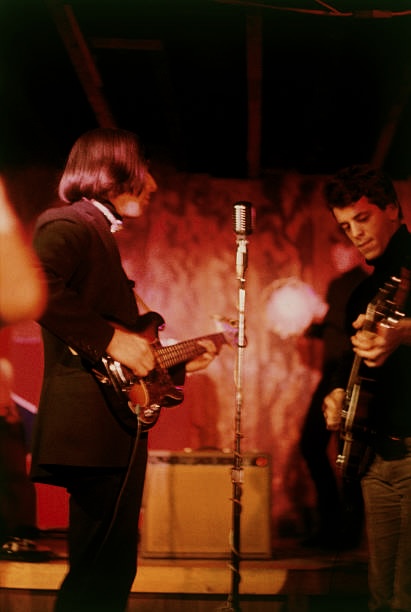
Ad un certo punto durante le session di registrazione di “I’m Waiting For My Man”, venne chiesto ad Andy Warhol se avesse qualche suggerimento da dare. Lui replicò: “perché non scrivete una canzone sulla paranoia?”. Paranoia era un suggerimento piuttosto appropriato per un brano che parlava di un eroinomane. Perché la paranoia è la forza che guida un tossicomane verso la costante e ininterrotta ricerca di droghe. “I’m Waiting For the Man”, fu registrata nel maggio del 1966.
A suonare sul pezzo c’erano Lou Reed come cantante e chitarrista principale, John Cale al piano e al basso, Sterling Morrison alla chitarra ritmica e Mureen Tucker alla batteria e tamburella. Un brano con una chitarra che si ripete in modo maniacale, un blues energico, un piano alla Screamin’ Little Richard e Lou con le sue perfette vocals. Questo brano ti porta così in profondità che ti senti di essere su un treno elevato, diretto verso il centro, seduto su un sedile con Lou accanto. Mentre cerchi “il tuo uomo”.
“Femme Fatale”: Nico in primo piano
Un altro brano con Nico alle lead vocals, registrato allo Scepter Records a New York City nell’aprile del 1966. Fu scritto da Lou Reed e riguarda l’attrice, modella e personaggio mondano del circolo di Warhol Edie Sedgwick. Fu ispirato ad un commento che Andy Warhol fece un giorno alla Factory. Mentre osservava Edie disse a Lou: “Non ti sembra una donna fatale, Lou”. Il pezzo è cantato da Nico alle lead vocals, Lou Reed alla chitarra e backing vocals, John Cale al piano e al basso, Sterling Morrison alla chitarra ritmica e backing vocals e Mureen Tucker allo snare drums e tamburella.
Il classico dei Velvet Underground “Venus In Furs”
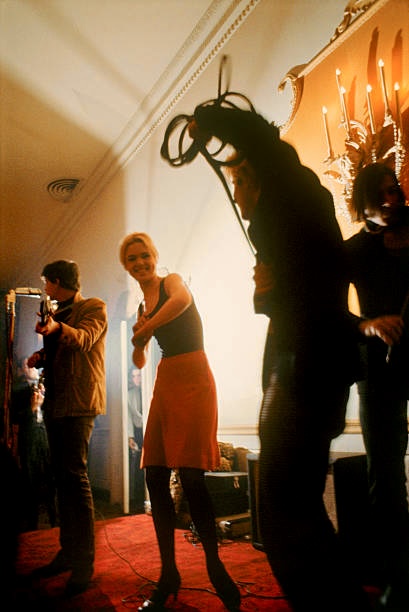
E’ considerata largamente come la più importante canzone dei Velvet Underground. Venne ispirata da un libro che portava lo stesso titolo. Alludeva ad un’eccentrico comportamento sessuale. “Venus in Furs” fu considerata scioccante ai tempi della sua release. Ma con la scarsa promozione da parte dell’etichetta discografica, l’esclusione dalle radio che la bandirono e la generale mancanza di interesse, furono poche le persone a sapere qualcosa della canzone o a quale album appartenesse. “Venus in Furs” fu registrata ai TTG Studios ad Hollywood nel maggio del 1966. C’è la viola eterea di John Cale accompagnata da un uso innovativo di due chitarre da parte di Lou. Ogni chitarra venne accordata in modo diverso. Una sull’open tuning, l’altra sulle corde DGCFAC. Vennero registrate precedentemente anche altre versioni del brano.
Le altre versioni di “Venus In Furs”
Tra queste esiste una demo con John Cale alle lead vocals ed un arrangiamento di fondo completamente differente. Qualcosa di rallentato, in stile vecchio folk inglese. Tra le altre versioni che negli anni sono state ritrovate ce n’è una registrata con un tempo più veloce agli Scepter Studios a New York City.
“Run Run Run”
Questo pezzo fu composto nel retro di una vista da lettere da Lou mentre si stava recando ad un suo concerto. Si incentra su un certo numero di personaggi e sul il grintoso mondo in cui viviamo. Il tutto intervallato da immagini che si riferiscono all’uso di eroina mischiate con l’immaginario religioso. Lou Reed suona la chitarra solista, ribattuta con un bel chorus, John Cale al basso, Sterling Morrison alla chitarra ritmica e Maureen Tucker alla batteria.
“All Tomorrow’s Parties” ispirata ad Andy Wahrol
Il pezzo si rifà alle osservazioni di Warhol riguardo gli attori, le attrici, i personaggi famosi e celeberrimi e tutte le altre figure di questo tipo che ti puoi immaginare. Ma anche persone comuni che vivevano nel suo quartier generale multimediale a New York City conosciuto come The Factory e le cose sorprendenti che queste persone avevano fatto o detto. “All Tomorrow’s Parties” fu registrata agli Scepter Records, a Manhattan, nell’aprile del 1966. Gli arrangiamenti sono costruiti intorno al piano, ispirato dal sound di Terry Reilly, amico musicale di Cale. Lou contribuì con la sua famosa chitarra Ostrich, chiamata così perché tutte le strings erano accordate in D. Sterling Morrison ha suonato il basso, Maureen la tamburella e il bass drum.
Side 2 di “Velvet Underground and Nico: “Heroin”
Venne composta da Lou nel 1964. In quel periodo i Beatles scrivevano canzoni che parlavano di tenersi mano nella mano. Lou scriveva invece “Heroin”, una canzone riguardo la dipendenza da quella sostanza e dagli effetti individuali che può provocare. “Heroin” fu registrata ad Hollywood. Sebbene le prime registrazioni fossero state effettuale in precedenza a New York City. E’ il pezzo più lungo dell’album, con una durata di 7 minuti e 12 secondi. 30 secondi più corta della canzone che chiude l’album, “European Son”. “Heroin” comincia lentamente con Lou alla chitarra e Sterling alla chitarra ritmica mentre il tappeto ritmico è fornito da Maureen. Si unisce poi la viola elettrica di John Cale che costruisce una pura, grezza, primordiale canzone di rock’n’roll.
“There she goes again”
Forse conoscete il brano “Hitch Hike” di Marvin Gaye o la grandiosa cover che ne hanno fatto i Rolling Stones. Allora potrete notare che le corde di apertura di “There She Goes Again” sono esattamente le stesse che aprono “Hitch Hike”. Il che potrebbe essere un accenno di Lou alla sezione ritmica della Motown Records. Il testo del brano è una descrizione di uno stato indotto dall’uso di droga. Non è difficile intercettare frasi come “scorre nel mio cervello, pulsa nelle mie vene”. Non lasciano molto all’immaginazione. Lou si è spinto davvero ai limiti di quello che era permesso su questo pezzo in cui canta e suona la lead guitar. John Cale è al basso e backing vocals. Sterling Morrison alla chitarra ritmica e alle backing vocals. Maureen Tucker suona le percussioni.
“I’ll Be Your Mirror”
Si tratta di un brano d’amore malinconico cantato da Nico. Un brano semplice e dal gusto folk, ispirata da Nico, almeno stando a quello che ha detto Lou. “Lou, I’ll be Your Mirror”. Non tutto scivolò via facilmente durante il processo di registrazione e ci furono dei momenti di polemica. Questi riguardarono per lo più il modo di cantare di Nico. Ma alla fine, quando il brano fu completato, tutti ne furono entusiasti. I musicisti includono Nico alle vocals, Lou alla lead guitar. John Cale al basso, Sterling Morrison alla chtarra ritmica, e Maureen Tucker alla tamburella. Esistono anche altre versioni di “I’ll Be Your Mirror” con backing vocals alternative.
“The Black Angel’s Death Song”
Ricco di immaginazione e influenzato dallo stile avant garde, il brano è stato scritto da Lou Reed e John Cale. La performance vocale di Lou è presentata con un fluire di pezzi parlati. Dei fraseggi innovativi, una specie di rap preistorico più che un brano semplicemente cantato. Nel brano Lou viene accompagnato da un violino scordato un po’ schizofrenico suonato da Cale. Quindi Morrison è alla chitarra e Tucker alle percussioni. “The Black Angels Death Song” è stata citata da molti come un brano di grande ispirazione per lo sviluppo della musica progressive, alternative e punk rock.
“European Song”
E’ una canzone lunga più di sette minuti, senza testo a parte il primo minuto. E’ dedicata al consulente universitario di Lou Reed alla Syracuse University. Sembra, infatti, che l’insegnante avesse un forte disprezzo nei confronti delle lyrics nelle canzoni rock. E’ il brano finale dell’album e anche il più lungo. “European Song” è lunga sette minuti e 46 secondi ed è stata registrata ad aprile del 1966. E’ un brano precursore di quello che sarebbe stato musicalmente il successivo album dei Velvet Underground. Stiamo parlando di “White Light/White Heat”, che include il brano “Sister Ray”, 17 minuti e 21 secondi di improvvisazione, feedback e distorsioni. Lou Reed suona la lead guitar, è alle vocals e agli effetti sonori. John Cale al basso, Sterling Morrison alla chitarra ritmica, Maureen Tucker alle percussioni.
Da flop a capolavoro del rock
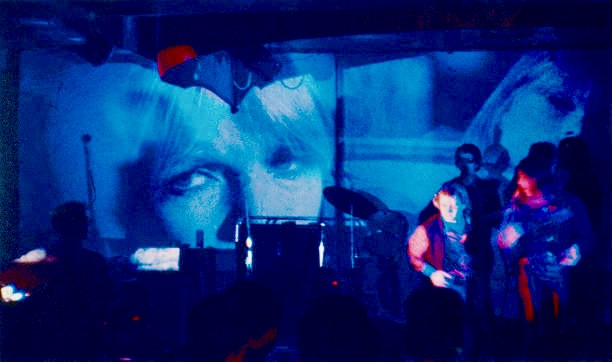
Sfortunatamente a cavallo della sua release nel 1970, il disco, uno dei più prestigiosi della storia del rock, fu un insuccesso. Non ebbe riscontro dal punto di vista commerciale e ricevette ben poca attenzione. Come abbiamo detto fu bandito da alcuni negozi di dischi e da quasi tutte le stazioni televisive a causa delle sue tematiche e del suoi testi scioccanti. Ma alla fine non tutto andò perduto.
Successivamente, “The Velvet Underground and Nico” divenne un disco estremamente ispirativo ed influente con l’acclamazione della critica. I critici musicali lo adorarono. Svariate band ammisero che i Velvet Underground erano una loro grande influenza musicale. Così anche il pubblico che acquista i dischi si mise su queste posizioni e salí a bordo. I Velvet Underground avevano finalmente conquistato i riconoscimenti che meritavano. Ma a quel punto, la band che aveva registrato questo magnifico album si era sciolta da un pezzo. E ognuno dei membri aveva preso la propria strada. Qualcuno tornò nell’oscurità, qualcun altro no. Lou Reed scelse di salpare per l’Europa e di collaborare con Bowie, Iggy e Eno. Ma questa è una storia di cui parleremo la prossima volta…
“The Velvet Underground and Nico”. Trials and Tribulations of an Art Rock Masterpiece”
The album was recorded in April, May and November of 1966 and released in March of 1967. Andy Warhol managed the band, financed it and designed the album cover for their first album. Which featured a Warhol creation, a plastic banana on its front cover, that peeled open exposing the banana inside. This plastic banana would be one of the reasons for the delay in the album release, were caused by delays during the production process.
The album features avant-garde music incorporated into minimally
hard driven rock music, combined with songwriter Lou Reed’s controversial lyrics.
A masterpiece of avant garde music
The Velvet Underground managed to create a completely unique art rock masterpiece. There was nothing like it at that time. It was an enigma that the world of commercial music wasn’t ready for. Parents were horrified, teenyboppers too, or at least the few that bothered to listen to it, or even hear about it.
Which was unfortunate because it was a groundbreaking
avant-garde musical expression tour de force.That tore up the rule book on how a rock song should sound. And was so far ahead of its time. It would be years before the album got the credit it was due.
The Velvet Underground’s line up
The members of Velvet Underground at the time of recording included, Lou Reed lead singer and primary
songwriter known for his distinctive spoken word vocals. Multi- instrumentalist, John Cale a native of Wales, added a unique experimental edge to the band’s music with a variety of instruments, while Sterling Morrison’s rhythm guitar brought a fuzz driven sound to the mixture, drummer Maureen Tucker contributed her minimal but impactful drumming style.
This collection of musicians were known for their avant garde and experimental sound sprinkled throughout with controversial lyrics.
Nico appears on the scene

Originally there were four members in the Velvet Underground, Lou, John, Sterling and Mureen. The were dark and edgy but Andy Warhol felt they needed something else. That something else was Nico, who had appeared in a number of Warhol films, with a voice that’s been compared to Marlene Dietrich. Andy holding the band’s purse strings then persuaded Lou to include Nico in the band,and although there were serious doubts about her, he went along with Nico joining the band. Nico would supply lead vocals on three tracks on the album, ‘I’ll Be Your Mirror”, “Femme Fatale”, “All Tomorrow’s Parties”, and also sang backup on “Sunday Morning” . In addition she toured with the band in Warhol’s, “Exploding Plastic Inevitable
Extravaganza”
.
”The Velvet Underground and Nico” album
was recorded in mid-April 1966. The bulk of the album was recorded in four days, with some additional re-recording taking place that same year. Initial recordings were at Spectre Records in New York City. Estimates on the cost of recording range from $1,500 to $3000. The album’s release was delayed for a while; there was a problem finding a label to release the album because of its controversial lyrics. But after shopping it around and being turned down to a number of record companies. The album finally found a home on MGM Records, Verve label. The album was produced by Tom Wilson.
Although strangely enough Andy Warhol is credited on the album cover as being the only producer on the album, most likely he was named producer because of his famously marketable name. And although Andy had little to do with the recording process other than paying for the recording sessions. Lou Reed and Sterling Morrison both have credited Warhol’s hands off production process,for giving the band the freedom to pretty much do things the way they wanted them done as far as the
album’s musical direction was concerned. With this artistic freedom the Velvet Underground would go on to brew up a quirky, and extraordinarily unconventional album, with lyrics and themes in a class by themselves.
A not very well welcomed album at its release
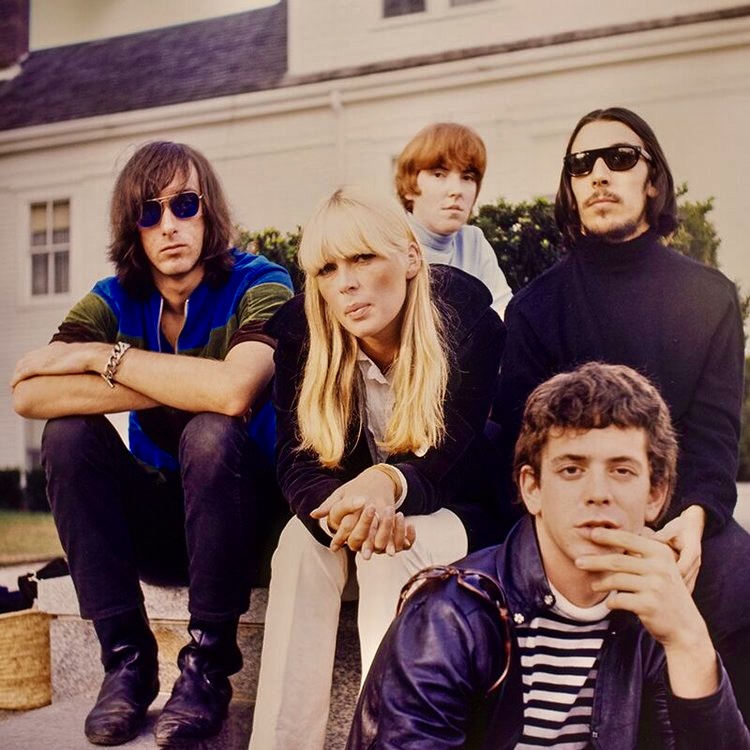
It was through an almost cosmic coming together of Lou Reed, Andy Warhol, Nico, John Cale, Sterling Morrison and Maureen Tucker, that the band would record a totally unique album.
It seemed to have come out of nowhere. Nothing sounded remotely like it before. Society just wasn’t ready for it. Radio stations refused to play it, newspapers, magazines etc refused to advertise it. It was weird, it had hideously appalling lyrics, it was totally out of touch with the current rock tastes. The album had everything against it but as fate would have it. All that would change in time. For by the mid-1970’s, the album, “The Velvet Underground and Nico”, an album with a small cult following, would become recognized as trailblazing and one of the most influential Rock albums ever made.
“The Velvet Underground and Nico” track by track
Side one of the album begins with, “Sunday Morning”: As recording progressed, Tom Wilson the albums producer, thought the album could use another
song by Nico. So shortly thereafter on a Sunday morning, Lou Reed and John Cale got together and wrote a song with Nico’s voice in mind. But Lou ended up singing lead vocals, while Nico supplied supporting vocals. John Cale contributed the celesta,viola and piano to help create a lush dreamy arrangement on “Sunday Morning”. While Lou accompanied on guitar and lead vocals, Nico backup vocals, Sterling Morrison bass and Maureen Tucker drums.
“Waiting for My Man”
At one point during the recording sessions of “I’m Waiting For My Man”, Andy
Warhol was asked if he had any suggestions.To which he replied, “Why don’t you make a song about paranoia”. Paranoia was a quite appropriate suggestion for a song about a heroin addict. For paranoia is the driving force in an addicts never ending search for drugs. “I’m Waiting For My Man”, was recorded in May of 1966 at TTG Studios in Hollywood.
Personnel on the track were Lou Reed lead guitar and vocals,John Cale piano and bass guitar, Sterling Morrison rhythm guitar, Mureen Tucker drums and tambourine. On a song featuring a manically repetitive guitar, a blues stomping, Screamin Little Richard style pounding piano, and Lou’s perfectly delivered vocals. This song takes you in so deeply that you feel as if you’re on the elevated train heading uptown sitting on a seat next to Lou. Searching for the Man.
“Femme Fatale”
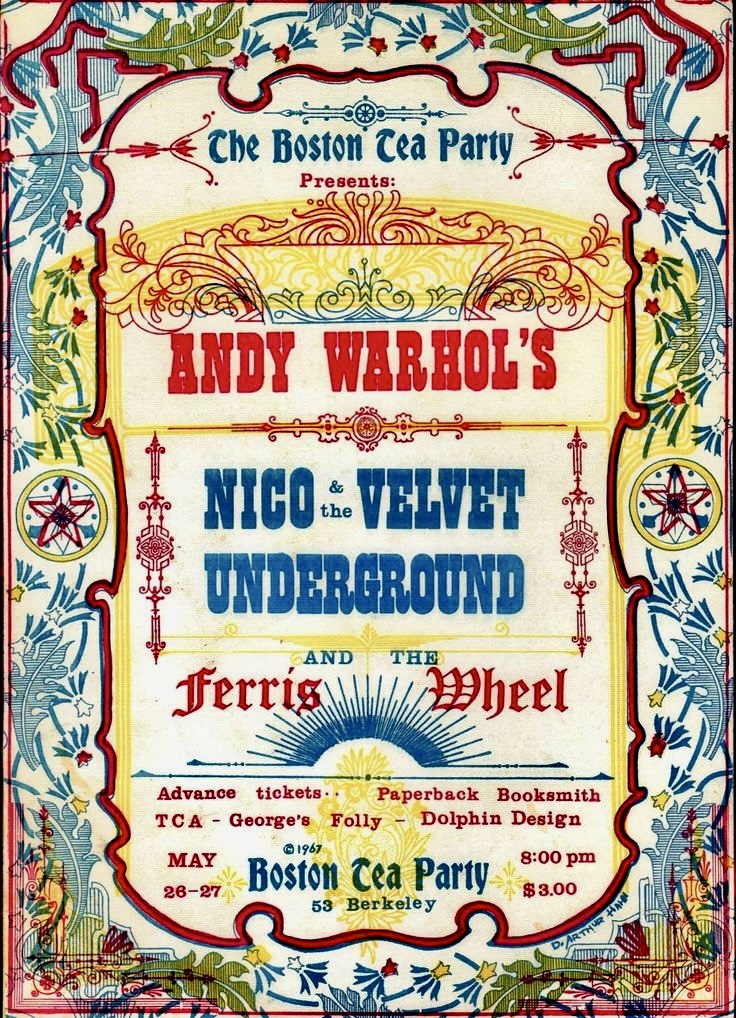
Another song featuring Nico on lead vocals, was recorded at Scepter Records in New York City in April of 1966. It was written by Lou Reed about actress, model, socialite and Warhol superstar, Edie Sedgwick. The song was inspired by a comment Andy Warhol made one day at the Factory, when he said to Lou, while observing Edie, ”Oh don’t you think she’s a femme fatale, Lou.” Personnel on the song included Nico lead vocals, Lou lead guitar and backing vocals, John Cale piano and bass guitar, Sterling Morrison rhythm guitar and backing vocals, Maureen Tucker snare drum and tambourine.
“Venus In Furs”
Is widely considered one of the Velvet Underground’s greatest songs. It was inspired by a book of the same name,which features lyrical themes alluding to sexually kinky activity. “Venus and Furs”, was considered shocking at the time of release. But with the poor record company promotion, its banishment from radio and just a general lack of interest,there weren’t many people that knew anything about the song or the album it was on. “Venus in Furs” was recorded at TTG Studios in Hollywood in May of 1966. John Cale’s ethereal electric viola is the featured instrument on the song. He’s nicely accompanied by Lou’s innovative use of two guitars, each tuned differently, one to open tuning the other tuned to DGCFAC.
A number of earlier versions of the song were also recorded. That includes a pretty awesome demo with John Cale on lead vocals,and a completely different backing arrangement, a slowed down sort of old English folk arrangement. Other versions that have surfaced over the years include one recorded at a faster pace at Scepter Studios in NYC and a few random live version.
“Run Run Run”
It was written on the back of an envelope by Lou on his way to a gig. It revolves around a number of individuals, and the gritty world they live in, that’s interspersed with images of heroin usage with religious imagery. Personnel on the song included Lou on lead guitar, double tracked on the chorus’s, John Cale on bass, Sterling Morrison rhythm guitar, Maureen Tucker drums.
“All Tomorrow’s Parties”
It was inspired by Andy Warhol’s observations of the, actors, actresses, famous and unfamous and every kind of hangeron you can imagine as well as your everyday person at his multimedia headquarters in New York City, known as the Factory, and the astonishing things these people said and did. “All Tomorrow’s Parties” was recorded at Scepter Records, in Manhattan in April of 1966. It’s arrangement centers around a piano inspired by the sounds of Cale’s musical friend Terry Reilly. While Lou made his contribution with his famous Ostrich guitar, so-called because all its strings were tuned to D. Sterling Morrison played bass, Maureen played tambourine and bass drum.
Side 2: “Heroin”
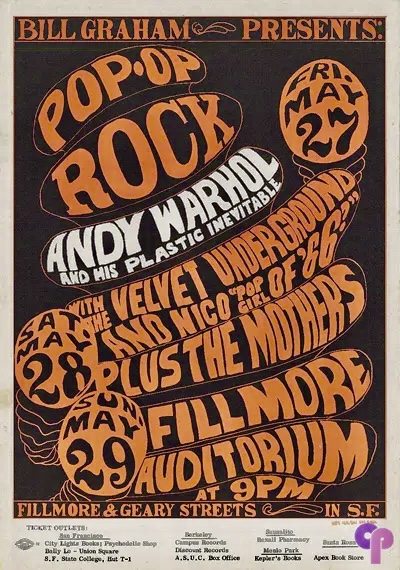
It was written by Lou way back in 1964. Around the time the Beatles were writing songs about holding someone’s hand. Lou wrote Heroin, a song about heroin addiction,its use and its effects on an individual. Heroin was recorded in Hollywood. Although recording had been done previously in New York City. It’s the second longest track on the album coming in at 7 minutes and 12 seconds, 30 seconds shorter than the album’s close out song,“European Son”. Heroin begins slowly with Lou on guitar, Sterling on rhythm guitar,drum patterns provided by Mureen before joining with John Cale’s electric viola built toward a pure, raw, primal rock and roll song.
“There She Goes Again”
If your familiar with Marvin Gay’s song “Hitch Hike”or The Rolling Stones great cover version of it. You’ll notice the opening chords of “There She Goes Again” are the exact same chords that open “Hitch Hike”. Which could be possibly a nod from Lou to Motown Records rhythm section.
“The song’s lyrics are a description of the feeling a drug induced state occurring. It’s not hard to miss drug referenced lyrics like, “racing trough my brain – pulsing through my vein”. It doesn’t leave much to the imagination. Lou really pushed the limits to what was permissible with this one. Personnel on the song are, Lou Reed lead guitar and lead vocals. John Cale bass and added backing vocals. Sterling Morrison rhythm guitar and backing vocals. Maureen Tucker percussion.
“I’ll Be Your Mirror”
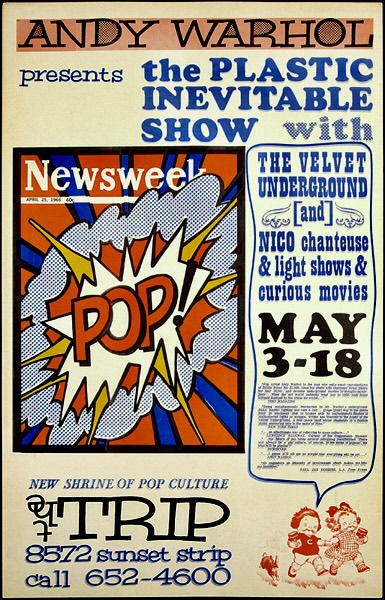
It is a melancholic love song with Nico on lead vocals. A simple and folksy song, it was inspired by Nico saying to Lou . “Lou, i’ll be your mirror”. Although all was not smooth sailing through the albums recording process,with some contentious moments. That mostly concerned Nico’s vocals. In the end though the song was completed to everyone’s satisfaction. Personnel on the song included Nico on vocals, Lou lead guitar. John Cale bass. Sterling Morrison rhythm guitar and Maureen Tucker tambourine. A few other versions of “I’ll Be Your Mirror” with alternative lyrics and backing vocals exist also.
“The Black Angel’s Death Song”
Rich in imagery influenced by avant garde art was written by Lou Reed and John Cale. Lou’s vocal performance is presented in a stream of spoken words, innovatively phrased like a prehistoric rap rather than sung. Lou’s accompanied on the song by a schizophrenic out of tune violin played by Cale, Morrison on guitar, and Tucker on percussion. “The Black Angels Death Song” has been cited by many as inspirational to the development of progressive, alternative, and punk rock.
“European Son”
A song that’s over seven minutes long,without a lyric past its first minute,is dedicated to Lou Reed’s advisor at Syracuse University who happened to have a strong dislike for lyrics in rock songs. The album’s final and longest track. European Son comes in at 7 minutes 46 seconds. Recorded in April of 1966. It’s a precursor of where the Velvet Underground’s sound would be going musically on their next album “White Light/White Heat”, that includes the song “Sister Ray”, seventeen minutes of mindblowing improvisation, feedback and distortion. Personnel on this one include Lou on lead guitar, vocals and sound effects, John Cale bass guitar and sound effects, Sterling Morrison rhythm guitar, Maureen Tucker percussion.
An album which would become a art rock masterpiece
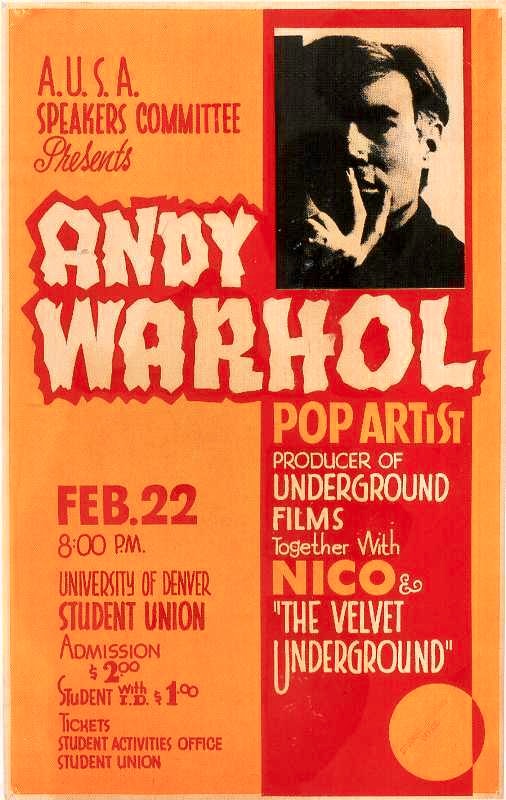
Unfortunately upon release in 1970, one of the most influential albums in rock history flopped. It was a commercial failure that received very little attention, was banned from some record stores, and almost all radio stations, due to its shockingly controversial themes and lyrics.
But in the end all was not lost. Eventually, “The Velvet Underground and Nico” became an extremely influential and critically acclaimed album. Music critics adored it. Bands professed the Velvet Underground’s influence.The record buying public jumped on board too. The Velvet Underground had finally got their due recognition. But by that time the band that recorded this magnificent album had long split up. They had all gone their own ways, some into obscurity, some not. Lou Reed chose to set sail for Europe to collaborate with Bowie, Iggy and Eno, but that’s a story for another day…
LEGGI ANCHE:
- Trinity de La Grazia Obliqua: talento eclettico in musica
- Una psichedelica Odissea Rock – Gli accordi spezzati di Roberto Maggi
- “Their Satanic Majesties Request”: il contributo dei Rolling Stones alla psichedelia
- GAZZARA – Criminal Sounds: il groove cinematografico dei polizieschi anni ’60-’70 rinasce in chiave jazz-funk
- Moody Blues: alla riscoperta di In Search of a Lost Chord, terzo mitico album della celebre rock band
- Franco Mussida presenta il suo nuovo romanzo autobiografico “Il Bimbo del Carillon”
- Are You Experienced? Immergiti nella Rivoluzione Sonora di Jimi Hendrix
- Pink Floyd Immersion: un’immersione nel mondo dei Pink Floyd
- I Pink Floyd Legend “The Dark Side of The Moon”
- Linguaccia Ribelle: Il Racconto Iconico Dietro il Simbolo dei Rolling Stones
- Marianne Faithfull: la vita e la scomparsa dell’icona pop musa dei Rolling Stones
- UFO Club: il locale che ha lanciato i Pink Floyd e ha fatto la storia della psichedelia inglese
Offerte Di Amazon Prime
Iscriviti ad Amazon Prime per guardare film e programmi TV popolari, inclusi i pluripremiati Amazon Original. Amazon Prime offre anche la consegna GRATUITA in un giorno sugli articoli Prime idonei e molto altro.

Amazon.it - ULTIMEA Soundbar TV, con Dolby Atmos/Digital/Audio, Sound Bar con Subwoofer, Bassi Profondi Regolabili, Soundbar 3D Dolby Surround TV, Soundbar per TV Home Theater, HDMI-eARC, Bluetooth 5.3, Nova S50
Miglior Prezzo 14900€
Spedizione in 1 giorno senza costi aggiuntivi
E molti altri vantaggi con Prime
Combatti La Muffa

Amazon.it - COMFEE' Deumidificatore Casa Muffa 12L/24h, Adatto fino a 20㎡, Filtro Lavabile, Ruote Piroettanti, R290, MDDN-12DEN7
Miglior Prezzo 11999€
4 mesi d'uso GRATUITO
Offerta a tempo limitato.
3 mesi gratuiti per i clienti senza abbonamento Prime.

Amazon.it - CAMP Rimuovi Muffa - Antimuffa per Muri Interni ed Esterni ad Azione Rapida, Spray Antimuffa Igienizzante Pronto all'Uso, Ideale per Rimuovere Muffe, Muschi e Funghi - Prodotti Pulizia Casa, 750 ml''
Miglior Prezzo 1590€
Il Meglio Dell'Intrattenimento

Amazon.it - Hisense TV 55" Mini-LED 144Hz 4K 2025 55U72Q, Smart TV VIDAA U8, Dolby Vision IQ, HDR 10+ Adaptive, 144Hz Game Mode PRO, Dolby Atmos 2.1 con Subwoofer, Alexa Built-in, VIDAA Voice, lativù 4K, 55''
Miglior Prezzo 54900€

Amazon.it - PERLESMITH Supporto TV Parete con Inclinazione Senza Attrezzi, Staffa TV Inclinabile da 26-65 Pollici Fino a 60 kg, Max VESA 400x400 mm
Miglior Prezzo 2589€

Amazon.it - Fire TV Stick 4K di Amazon (Ultimo modello), Dispositivo per lo streaming con supporto per Wi-Fi 6, Dolby Vision/Atmos e HDR10+
Miglior Prezzo 6999€













